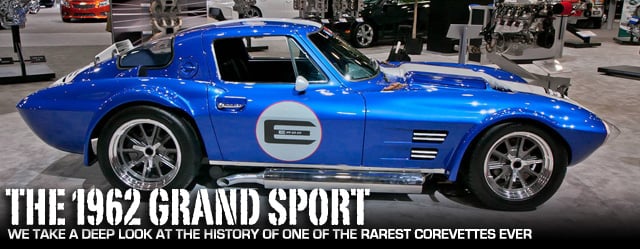How it Began
Racing frustration and competitive contempt were the driving force behind the creation of a legend in motor-sports – the C2 Corvette Grand Sport – one of the rarest models ever assembled. Fed up with the crushing losses Chevrolet endured from Ford and Carrol Shelby’s formidable Cobras, in early 1962 Corvette Chief Engineer, Zora Arkus-Duntov, began a top secret project to put an end to the humiliating domination.
The Corvette’s paternity rightfully belongs to Harley Earl, a visionary and the first head of General Motor’s design staff. While the initial C2 design is credited to Larry Shinoda under the direction of GM chief stylist, Bill Mitchell, it was the Russian engineer with a hot-rodders’ DNA who dialed-up the elegantly curved fiberglass, metal, and rubber, giving it a hardened performance edge. This was the birth of the Grand Sport.
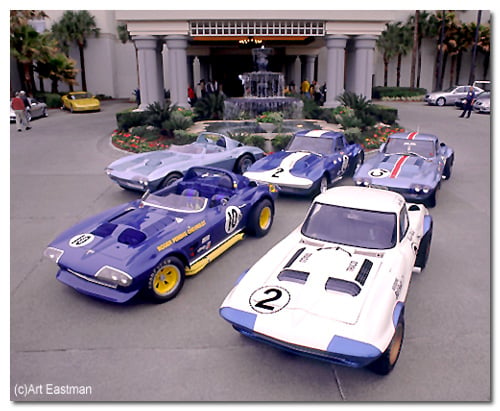 [2]
[2]All five of the original C2 Corvette Grand Sports came together for a rare photo-op at the 2003 Amelia Island Concours d’Elegance. (No. 1-5 clockwise from left front: Art Eastman [3])
In Arkus-Duntov’s shop the Grand Sport project was known as the “Lightweight,” because it weighed in a full thousand pounds less than the production Sting Ray. The production Corvette weighted in at over 3,100 pounds, which was 50-percent more than the competition. Consequently, as the five original prototypes were being built, saving weight was a key goal from the get-go. The production car’s burly steel “birdcage” was replaced by a comparable unit fabricated from lighter aluminum.
Paper thin, single-layer hand-laid fiberglass body panels were bonded to the new cage. Stamped steel wheels were upgraded with cast magnesium wheels. Lightweight aluminum castings saved even more weight in the steering gear box and differential housing. Arkus-Duntov also did away with the spilt rear window, reasoning that it created a safety risk and reduced visibility.
The dramatically formed and sculpted, lightweight Grand Sport was indeed the ultimate Corvette, enormously powerful, aggressive and functional, yet at the same time totally balanced and sleek. Adorned with scoops and vents and its trademark fender flares, the striking visual profile realized functional goals with imagination and intuition that has rarely ever been seen on race cars. The hand-built Grand Sports were ultimately powered by 377 cubic-inch (6.2 liters) small-block V8s, which were fed by four 58mm Weber side-draft carburetors through a special aluminum cross-ram manifold. The engine was claimed to produce 485 horsepower at 6,000 rpm. The Grand Sport rolled soundly on a 98-inch wheelbase.
Intended as a series of 125 cars, the “Lightweight,” was clearly purpose-built to blow the paint off Shelby’s Cobras, or anyone else that got in their way at FIA endurance races and ultimately the 24 Hours of Le Mans. The enthusiasm generated by the Grand Sports involved much more than simply beating Cobras though, it entailed the prospect that a production-based American sports car could beat the celebrated sports car badges from Germany, Italy, and Britain in mythical endurance battles contested at Le Mans, Daytona, Targa Florio, Sebring, Spa Francorchamps and Monza. Additionally it would be tasked to hold up the home team’s respect on America’s road racing circuits.
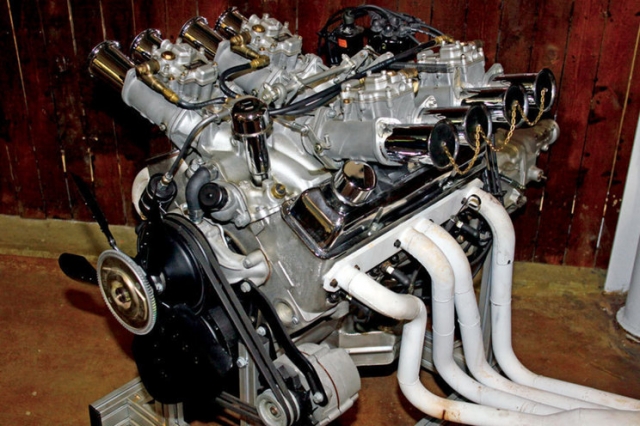 [4]
[4]The Grand Sports 377 cubic-inch engine was the vision of Corvette Chief Engineer, Zora Arkus-Duntov, it fed off four 58mm Weber side-draft carburetors and produced 485 horsepower at 6000 rpm. Corvette Magazine [5]
Disappointingly, the Grand Sport program ended the same year it was created, owing in part to a toughened corporate ban on racing by General Motors. But why then,and why the Grand sport, with its seemly unlimited promise for the time? The Grand Sport project would never realize the corporate backing needed to keep pace with their competitor’s hefty budgets.
From the start Arkus-Duntov was viewed as the consummate outsider at GM, a maverick who was more times than not misunderstood, and not always in line with the business of producing high-volume automobiles for the corporation’s volume division. When GM executives learned of Arkus-Duntov ‘s clandestine C2 Corvette Grand Sport program, the Chevrolet boardroom put a kibosh to the car’s construction. Although by then it was too late to stop the five Grand Sports already completed.
The Grand Sport in Action
In December of 1962 Arkus-Duntov and his crew took Grand Sport No. 001 to Sebring for testing, and since the 377 cubic-inch engines were still under development at the time, the car ran with a modified production L84, fuel-injected 327 engine instead. The disc brakes proved to be a problem (larger, vented rotors would later be installed) still, after running within seconds of the track record, the testing program was understandably deemed a success. Reports of the Sebring test reached GM’s Chairman Frederic Donner though, and in January of 1963 word came down that all racing efforts were to be stopped. The FIA application for homologation was immediately withdrawn. Without further explanation GM had made the decision to follow the 1957 AMA anti-racing resolution to the letter.
With all factory racing support now officially gone, Grand Sport No. 003 was loaned to Dick Doane (a Chevy dealer) and No. 004 went to Grady Davis (a famous oil tycoon)for racing in SCCA events. Their results were mixed, but after a number of modifications, Davis, with Dick Thompson at the wheel, successfully delivered No. 004 to an overall victory at the August, 1963 SCCA Nationals at Watkins Glen. Both cars were returned to Chevrolet two months later in October.
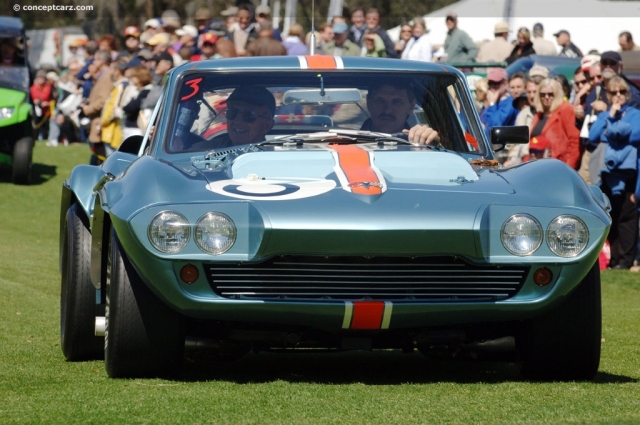 [6]
[6]Owner Grady Davis, with Dick Thompson at the wheel, drove Grand Sport No. 4 to an overall victory August, 1963 at the SCCA Nationals held at Watkins Glen. This photo was taken at the 2003 Amelia Island Concours d’Elegance where all five original “Lightweight” siblings gathered for an exclusive family reunion. ConceptCars [7]
After being returned, the Grand Sports No. 003 and No. 004, and the un-raced No. 005, were modified to reflect what was learned on the track. Slots and vents were opened up in the bodywork to increase brake and differential cooling. Wider 9-1/2 inch wheels and tires were fitted, which resulted in the addition of the fabled fender flares. Shortly before the axe fell, Grand Sport No. 001 and No. 002 had been radically altered for a scheduled run at Daytona. Their tops were cut off to convert them into roadsters and new hoods were engineered to reduce pressure that built up under the front end during races.
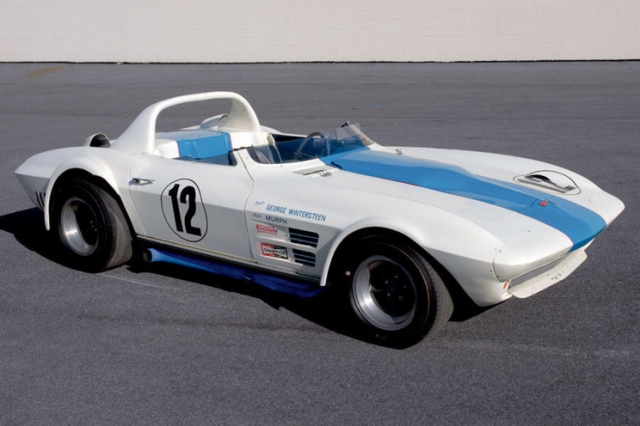 [8]
[8]Corvette Grand Sport No. 002 is currently owned by Dr. Frederick Simeone and resides in Simeone Foundation Automotive Museum in Philadelphia. Corvette Magazine [5]
At the time the door resoundingly slammed all the way shut on the program, the five existing cars were quietly hidden away within the dark recesses at Chevrolet’s Research Center. The two roadsters, which were now the rarest of the rare Grand Sports, were immediately sold to private teams, preventing them from being destroyed, according to corporate demands. Grand Sports coupes No. 003, No. 004, and No. 005 were quickly handed over to John Mecum, who ran a private team in Texas (Roger Penske bought the roadsters in 1966. Prior to the Sebring race, he reportedly installed heavy-duty 427’s and both cars ran with those engines that year).
A Learning Experience
For Arkus-Duntov and the Grand Sports crew, befitting vindication for their dedicated efforts came swiftly and decidedly during the 1963 Nassau Speed Week. Entered in the event by the new owner, Mecum and supported by a team of Chevrolet engineers who had all conveniently chosen Nassau for a one week vacation, the extraordinary performance of the cars simply pulverized their Cobra rivals. After the race drivers Roger Penske, Jim Hall, Dick Thompson, John Cannon, and Augie Pabst gathered with the Chevrolet engineers, in what amounted to a snarky smirk-fest at their victory over the hated Cobras.
Generally, if a car has any chance at reaching legendary status, it happens after they hang up their racing colors, but the Grand Sports reached mythical status before they ever made a showing on the track for their first run. Today all five of the original Grand Sport Corvettes still exist, thanks in large part to the dedication of a handful of extremely serious collectors. As a result of their compelling back-story and because they represent America’s iconoclastic automotive spirit, in designing and building cars for competition at the highest international levels, these five legends are as rare as an authenticated Jackson Pollack and quite nearly as valuable.
In 2008, despite all the anticipation and excitement surrounding the sale of the Grand Sport chassis No.002 at RM Auction’s Automobiles of Arizona, the Corvette failed to reach reserve and remained unsold. The renowned race car was expected to sell anywhere from $7-$10 million based on early estimates, but regrettably the bidding stalled at $5 million, short of the undisclosed reserve price. Serious collectors, with exceedingly deep pockets, can continue to keep that dream of owning a Grand Sport alive for a while longer.
